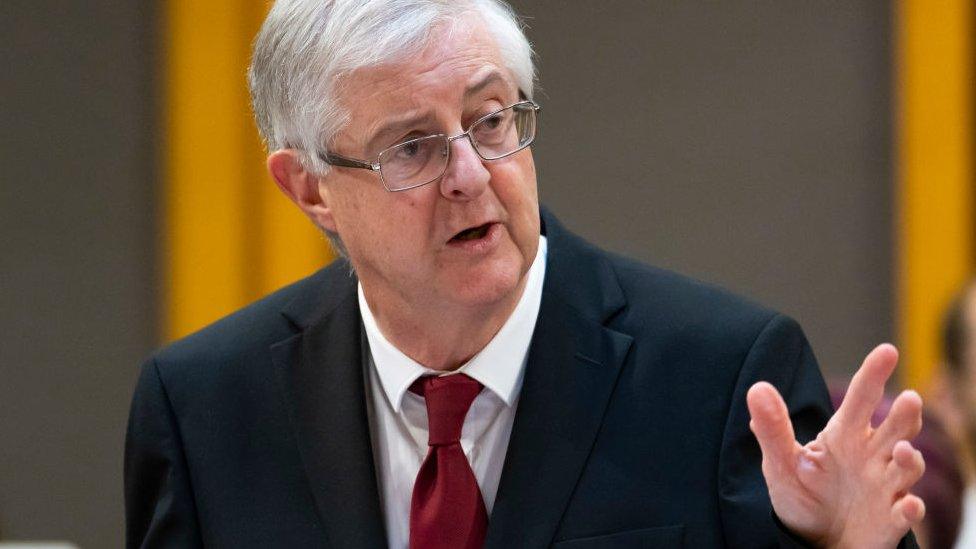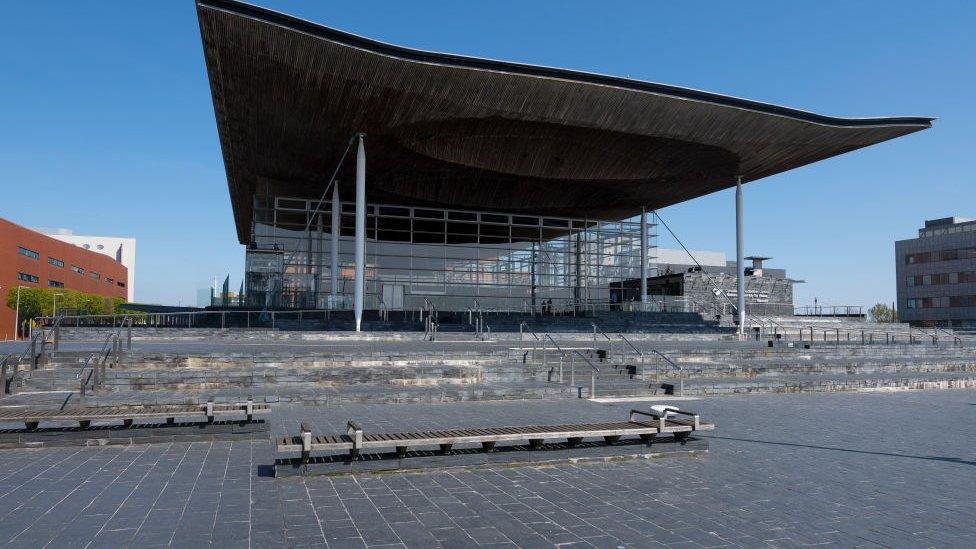Senedd: 36 more Welsh Parliament members could cost extra £18m
- Published
- comments

The number of Members of the Senedd, or MSs, will increase from 60 to 96
Bringing 36 more politicians to the Welsh Parliament could cost as much as £17.8m extra a year, new figures suggest.
Documents from Labour ministers have estimated the cost of a bigger Senedd for the first time.
Costs could reach £19.5m in 2030, on top of the Senedd's existing budget of £67m.
Supporters say more politicians are needed because the Senedd has more powers than it did when it was set up.
But the Welsh Conservatives said Wales needs "more doctors, dentists, nurses and teachers, not more politicians".
The Welsh government said it was a "once-in-a-generation opportunity to... strengthen our democracy".
First Minister Mark Drakeford said the estimates were at the "top-end" of the possible cost and that he hoped it would be less than that.
As well as bringing the number of MSs to 96, the changes will significantly overhaul the voting system, and will come into effect a year or two after the number of MPs is cut from 40 to 32.
The costs were published alongside the legislation that two-thirds of the existing Senedd will need to pass, before coming into effect at the next election in 2026.

Analysis by Gareth Lewis, BBC Wales political editor
As much as £17.8m a year on average. £8m in set-up costs.
Small in the scale of the overall budget but significant in the scale of a Welsh government looking to make huge savings - and unable to afford the £15m cost of free school meals during the recent summer holiday.
It follows another law that has split opinion - the new 20mph rules in residential areas, with one-off set up costs of around £30m.
The Welsh government is clearing the road of potentially unpopular policies, with a long way to go until the next election in 2026.
Supporters of reforming the Senedd argue that for many people there is never a good time to spend money on more politicians, but that Wales desperately needs them to cope with the workload. The Senedd is significantly more powerful than when it was set up as the Assembly a quarter of a century ago with the current 60 members.
The minister in charge of the bill concedes it is a hard sell to voters.
From 2026 we can all start to judge whether 36 more politicians is money well spent.

How much will the new Senedd cost?
The affordability assessment from the Senedd, which was adjusted for inflation, suggests costs will be higher in years with elections.
It says in the first year of operation the new parliament could cost from £14.8m to £17.7m, before falling to between £13.9m and £16.8m in 2027/28.
In 2030/31, that could rise to at least £16.3m and as much as £19.5m, before falling again the next year to between £14.8m-£18.05m.
The larger figures suggest a scenario where there are as many as five party groups, up to three additional committees, an extra day of week for debates and an additional sitting week.
The higher estimates work out at an average of £17.8m a year between 2026 and 2032.
The smaller figures assume up to four party groups, one additional committee, a similar level of debate time to now and a similar number of sitting weeks.
The Welsh government said there would be set-up costs of £8m, and argued the costs represent a tiny fraction - 0.07% - of the £24bn overall Welsh budget, which includes spending on the health service and education.
Costs include MS and staff salaries, as well as the cost of redesigning the Senedd chamber itself.
It does not include a new building to house the new members - its assumed that with many Senedd staff now working from home it would not be required.
A total of £2.2m has already been spent by the Welsh government this year.
How will the new Welsh Parliament work?
The changes will bring the total number of Members of the Senedd from 60 to 96, increase the number of ministers that can be appointed from 12 to 17, and significantly change the way MSs are elected.
MSs will be voted through a system called "closed lists", where people will back parties rather than individual candidates, using a system which aims to elect people based on the proportion of the vote they get.
Currently elections use a mix of first past the post, where the candidate with the most votes wins a constituency seat, and lists in regions.
If agreed by two-thirds of the Senedd, the legislation will take effect from 2026.
At that year's election 16 constituencies will elect six MSs each.
The constituencies will be made up from the reformed 32 Westminster seats coming into effect at the next general election, with the seats paired with each other under a review due to be complete by April 2025.
All future candidates for Senedd elections must live in Wales, and elections will be held every four years from 2026.
There will be no by-elections - vacancies created during a term will be filled by people already selected in a party list.
If for some reason the list is exhausted, or only had one person on it, the seat will be left vacant.
The design of the system was originally agreed by Mark Drakeford and former Plaid Cymru leader Adam Price last year.

Mark Drakeford drew up plans for a 96-seat Senedd last year
'I hope it will be less than that'
Mark Drakeford, First Minister, said the £17m estimate was "at the top end of what it will cost".
"I hope it will be less than that," he said. "It will be 2026 before any of these bills have to be paid, that's plenty of time to prepare.
"A Senedd that is better equipped to scrutinise the £20bn that is spent in the Senedd. I think will do a more effective job of that, and as a result money will be better spent in Wales."
Plaid Cymru leader Rhun ap Iorwerth said the costs were "modest expenditure" and the changes would help the parliament "save money".
Welsh Conservative Shadow Constitution Minister Darren Millar said: "The Labour government should be focused on addressing unacceptable NHS waiting times, poor standards in schools and the lacklustre performance of the Welsh economy, not wasting time, energy and taxpayers' money developing yet more legislation on Senedd reform."
But Jessica Blair of Electoral Reform Society Cymru said Wales had what was "in effect a part-time parliament as it has not had enough members to fully scrutinise vital legislation and significant decisions about how public services are run".
"It would not have been acceptable in any other part of the UK to have a parliament smaller than nearly half of local authorities in the country - this reform is long overdue," she added.
But she said ERS had concerns about the proposed voting system, which "will remove the chance for voters to be able to back individual candidate".
The Liberal Democrats previously expressed concern that the voting system could freeze them and other small parties out of the new Senedd.
Welsh Lib Dem leader Jane Dodds said: "The people of Wales deserve a Senedd that is fit for the job now, and in the future. This isn't just about electing more people to the Senedd for the sake of it."
What happened to gender quotas?
The legislation published on Monday excludes plans to enforce gender quotas on lists of candidates.
That is because of legal fears related to whether the plan goes beyond the powers of the Senedd, and whether the UK government or someone else would want to challenge it in the courts.
The separate law is expected to be published later in the year but no date has been set.
Counsel General Mick Antoniw said: "This is a once-in-a-generation opportunity to create a modern Senedd, which truly reflects Wales, and to strengthen our democracy."
Related topics
- Published6 August 2020

- Published12 December 2017
